A couple of weeks ago, I started an article series on the history of promotional cards in Magic. You can find the first part here.
The idea behind this series is to take a look at the history of every promo in Magic and shed light on which cards are the most interesting and valuable. Hopefully, this will help you identify oddball cards in your own collection or in someone else’s trade binder that you might not have otherwise known about.
Before getting to the promos, though, I do have a few Return to Ravnica notes:
If you happened to attend a Prerelease that wasn’t sold out, see if they have any of the sealed guild boxes for sale. These will be a collector’s item, and they are worth picking up for the full retail price of $25/box. If not, see if you can snag some of the spindowns in trade for a couple of bucks each. People are going to want these a couple years down the line. At my Prereleases, no one was willing to trade theirs at all. They will be very popular. (Though according to Mark Rosewater, they’ll be in the fat packs too, so don’t go nuts.)
There are lots of rumblings of Return to Ravnica product allocation getting even worse. One of my local stores isn’t cracking boxes for singles at all because otherwise there wouldn’t be enough product to draft. If there isn’t enough Return to Ravnica to go around, expect the current outrageous singles prices to stay high longer. I’m not trading for Ravnica cards right now unless the deal is right, but I’m not willing to part with them for less than retail either.
Make sure to stock your binder with the best commons and uncommons for the first month of the set’s release. Charms and Dryad Militant are early winners.
Patrick Chapin is removing Talrand from his Delver decks now that Phyrexian mana is a thing of the past. If you have any of these, trade them immediately. In addition, Woodland Cemetery is in a very good Golgari Event Deck. They aren’t going up from $15. Sell. Ditto Thragtusk.
The more I see it, the more I think Jace, Architect of Thought will sustain a $30+ price tag for a little while. It’s a terrific card. Other cards that are generating increased buzz since the Prerelease: Deathrite Shaman and Sphinx’s Revelation.
Remember that aggro decks generally set the tone of Standard early on—it takes control a while to catch up. I think Zombies will come out of the gates fast, and cards like Lotleth Troll may actually rise in price (or at least demand) before falling off later in the season.
Anyway, on to the promos! This week, I’d like to start by talking about the longest running set of promotional cards in the game. Beginning with Tempest in 1998, this series of promos has been tremendously popular with casual players for the past fourteen years. I’m talking, of course, about:
Prerelease Cards
For the first three sets, Tempest, Stronghold, and Exodus, Prerelease cards weren’t foil. Heck, foils weren’t even a thing yet. Instead, the cards simply have ‘Prerelease – <date>’ printed on them in gold next to the expansion symbol. None of these three cards are particularly desirable, and they only hold a value of $3-$5 based on historical interest.
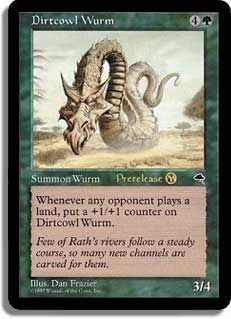
Foil Prerelease cards started with Urza’s Saga. In fact, the Urza’s Saga Prerelease card Lightning Dragon was the first foil most players of that era had a chance to see. Foil cards weren’t added into regular packs until the second set in the block, Urza’s Legacy, so this Dragon was truly special for a couple of months. For years, it was the card that many casual players were most proud of owning. These are nearly impossible to trade for even now—people who got it as their first-ever foil are still attached to it. Today, Lightning Dragon still holds a value of $10 while none of the other promos in Urza’s block or Masques block have broken $4.
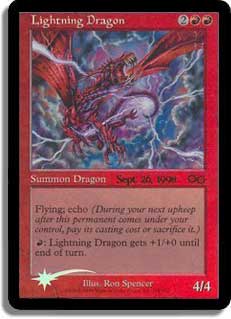
For the next two blocks, Invasion and Odyssey, Wizards gave out Prerelease cards printed in obscure foreign languages. Invasion’s Raging Kavu was printed in Latin. Questing Phelddagrif was printed in Greek. Fungal Shambler was printed in Sanskrit. Stone-Tongue Basilisk was printed in Arabic. Laquatus’s Champion was printed in Cyrillic. Glory was printed in Hebrew.
In today’s world of Magic design and marketing, it boggles my mind that Wizards actually did this—and it’s staggering that they kept it up for two full years. Prereleases today are designed to be gateways for casual players to enter the world of organized play. Imagine giving those players a brand new card that they had never seen before in a language that they didn’t understand.
Even today, these foreign cards aren’t especially popular. Only Glory has reached $3, and that’s because it’s a marginally playable card in Commander. I still have an easier time trading normal English versions to Commander players, though.
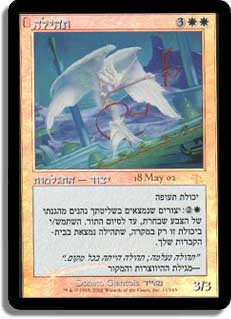
Beginning with Onslaught, Prerelease cards started coming with expansion symbol watermarks in the text box in addition to gold printed date in the type line. The foreign language promotion was over, but the prices of these cards are still very low overall. Wizards chose rares designed to highlight new mechanics, but they were all casual and competitive flops.
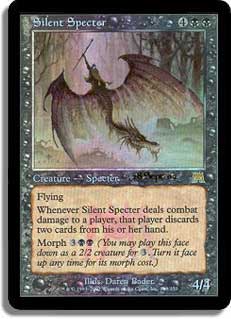
Things changed again in Mirrodin block. Along with the new card frame came increased Prerelease card quality and, for the first time, alternate art. From this point forward, all Prerelease cards have had different art from the version printed in the set.
Sword of Kaldra was also the first Prerelease card that wasn’t a creature. It was also the first piece of equipment most players ever saw. The Kaldra cycle is still very popular, and these promos retail between $5 and $7.
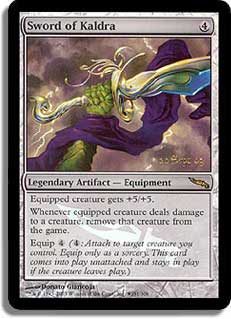
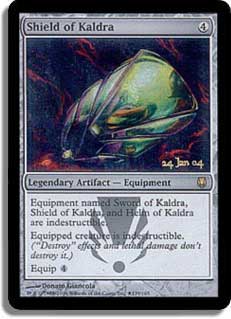
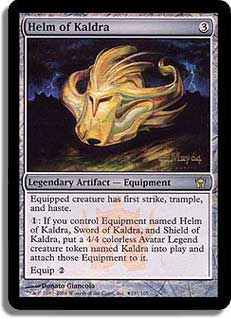
The style of Prerelease cards didn’t change again for the next six years. Other than the Kaldra Cycle, a handful of others from this era still hold value. Ink-Eyes, Servant of Oni sells for $10. Lotus Bloom and Door of Destinies sell for $8. Korlash, Heir of Blackblade sells for $6, and Demigod of Revenge sells for $4. The rest all book for $2 or less.
Shards of Alara brought a sea change: the first (and only) planeswalker as a Prerelease card. While it wasn’t the first planeswalker that most people saw, (Garruk and company made their debut in Lorwyn the year before), it was the first multicolored planeswalker as well as the first ever mythic rare.
For the next three years—Shards block, Zendikar block, and Scars block—the Prerelease cards were all mythics. During this period, Prerelease cards held an unprecedented amount of value compared to any other point. Emrakul, the Aeons Torn is far and away the most valuable Prerelease card of all time, tipping the scales at $20. Wurmcoil Engine sells for $12. Vampire Nocturnus sells for $10. Hero of Bladehold, Dragon Broodmother, and Sun Titan all sell for $5. Many of these cards impacted tournament play and sold for even more when they were Standard legal.
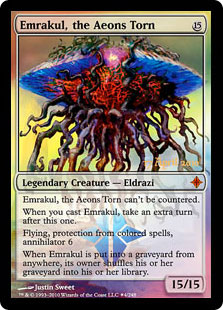
Starting with Innistrad, Prerelease cards were downgraded from mythic to rare. This has by and large destroyed the value of these promos—Mayor of Avabruck $2 price tag is the heftiest of the bunch. Mark Rosewater stated that he felt the existence of the Prerelease card ‘cheapened’ one of the mythic slots in a set, making it feel more common and less special than intended. This may be so, but it has also turned the Prerelease card into an Onslaught era afterthought once more.
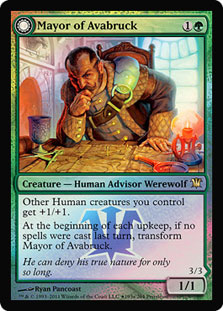
While Return to Ravnica continues Innistrad’s trend of bulk rare promos, it is the first time multiple Prerelease cards have been available at the same event. Even though each card is quite a bit rarer than the earlier promos, I don’t expect any of them to rise in value unless the card itself makes waves in Standard.
Release/Launch Party Cards
From Betrayers of Kamigawa through Dark Ascension, Magic had ‘Launch Parties’ on the weekends after Prereleases. Back when Prereleases were large regional affairs, Launch Parties were essential as a way to get people to addend their local store. After Prereleases went local, though, they became kind of superfluous.
Starting with Avacyn Restored, Launch Parties were discontinued altogether. However, the foils weren’t axed completely. Instead, each player who attends the FNM directly following the set’s release gets a free alternate-art foil rare—same as if they had gone to a Launch Party.
The first two release foils are actually from the year before Betrayers of Kamigawa. Both are rares—Rukh Egg from Eighth Edition, and Ass Whuppin’ from Unhinged. Neither is particularly valuable—the Egg sells for $1, and the Unhinged card goes for $2. Champions of Kamigawa had no release tournament or accompanying card. Instead, the series started for good beginning with Betrayers of Kamigawa.
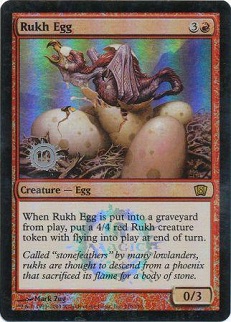
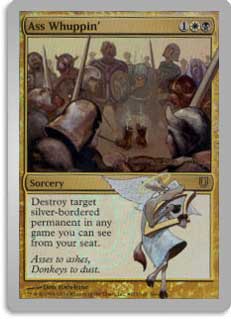
Back then, these tournaments were relatively unknown and sparsely attended. I remember my group of friends was the entirety of our game store’s Saviors of Kamigawa release event. We each got a full playset of promos just for showing up.
For the next few years, the release foils for the expansion sets were uncommons while the base set release promos were rares. In terms of the rares, Ninth Edition gave us Force of Nature, and Tenth was Reya Dawnbringer. For whatever reason, Reya was overprinted massively compared to demand and many stores had dozens of these left over after their events. For years, you could get these promos for $1 without much issue. It speaks to the causal power of this card that it’s up to $4 now. The Force of Nature is still just $1.
None of the Launch Party uncommons from this era are worth more than a buck or two. The only significant Launch Party card from this era is the Marit Lage token from the Coldsnap release. It’s one of the only foil tokens ever printed, and it goes with a land that is beloved by casual players and has been a tournament staple as well. Couple that to the fact that very few people attended any of the Coldsnap events, and I’m shocked this card still sells for just $8.
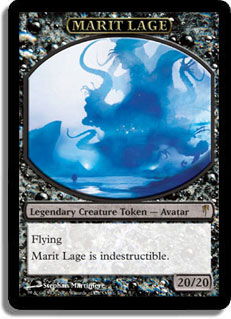
Starting with Morningtide’s Earwig Squad, release foils scrapped the uncommon plan and went to rares only. Starting with Conflux, release foils all went alternate art as well. (There was no release foil for Shards of Alara—the same Ajani Vengeant promo was handed out on both weekends.)
Most release foils from this era are undesirable, but there have been a few standouts. Phyrexian Metamorph sells for $6. Figure of Destiny sells for $5 and was quite a lot more expensive when it was legal in Standard. Valakut, the Molten Pinnacle is currently at $4, mostly due to Modern speculation after being recently unbanned.
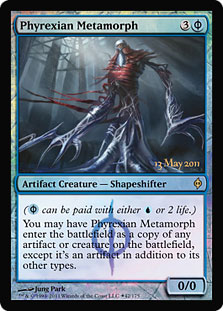
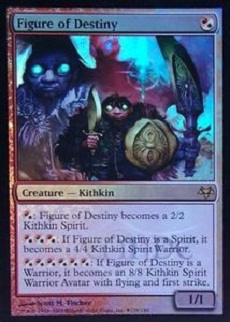
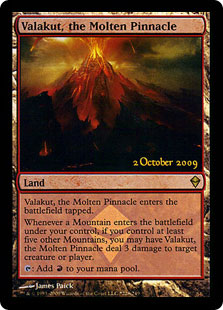
The only release foil currently worth more than $10? Restoration Angel at $13 from Avacyn Restored.
FNM Cards
Starting in February of 2000, FNM cards were given out to four players per event at Friday Night Magic: the two players with the best record and two random participants. Ever since, there has been a new card available each month. The FNM foil giveaway is still a very successful promotion, and these promos are generally well regarded among players of all psychographics and skill types.
From the start, FNM cards have always been commons and uncommons. To date, no rares have ever been released as FNM foils. I don’t expect that to change anytime soon.
The first six FNM cards (as well as the eleventh, Staunch Defenders, in what was probably an out-of-order release) simply had the Sixth Edition expansion symbol and shooting star. They are not otherwise identifiable as FNM promos. This was par for the course for the era—there were no non-promo foils released for Sixth Edition, but FNM, the Arena League, and the Judge Program released Sixth Edition foils as promotional cards.
The only one of these cards worth more than $4 is Terror, which sells for $10. This is likely due to the fact that this is the only original art foil version of the card, which is popular in Cube.
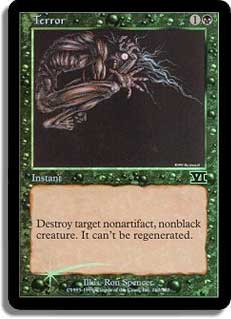
Starting with Giant Growth in August of 2000, FNM foils were printed with a DCI logo in place of the expansion symbol. This continued all the way through Disenchant in July of 2003. This era contained many of the most valuable FNM cards, starting with the granddaddy of them all, Swords to Plowshares.
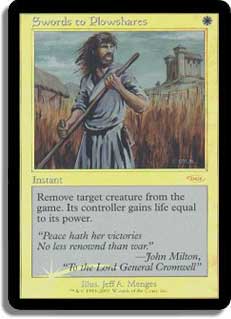
This is still the only foil version of the card to ever see print. Up from $50 a couple years ago, this card now sells for a whopping $110 and demand shows no sign of letting up.
Other big money cards from this run include Priest of Titania at $25, Capsize at $20, Dissipate at $15, Impulse and Fireblast at $10, Wall of Blossoms, Goblin Bombardment, and Aura of Silence at $8, Carnophage at $7, and Black Knight at $6.
The card for March 2003 was supposed to by Crystalline Sliver, but this release never happened. Someone stole almost the entire print run of FNM Crystalline Slivers from a WotC warehouse, and the company was forced to move up their promotions schedule by a month. July’s Disenchant wasn’t supposed to exist—it was printed (without a collector’s number) to replace Crystalline Sliver so there wouldn’t be a gap.
Years later, most of the stolen Slivers were recovered. Wizards gave them out to people attending Pro Tours and Grands Prix. Today, Crystalline Sliver sells for $6 and Disenchant is worth $7.
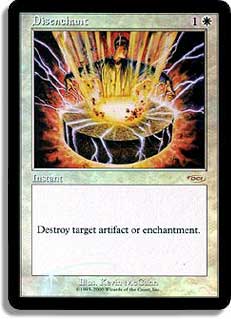
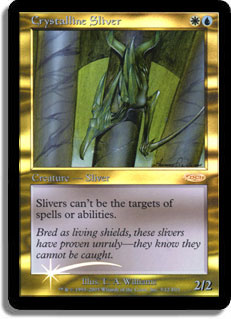
Starting with Smother’s release at the beginning of Mirrodin block, FNM promos switched to the new card frame. The DCI logo was kept, and an FNM watermark was added to the text box. The content of the cards was also changed. Before, FNM cards were largely older cards, many of which had never seen a foil printing. Many of these cards were Extended staples, and the promo series was catered toward tournament players. Starting with the new card face, the promos were instead made up of cards from the current or previous block in an attempt to please Standard players. The only notable FNM card from this year is Krosan Tusker, which sells for $4.
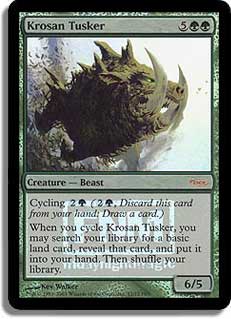
This continued for about a full year until the release of Treetop Village as a promo in July of 2004. From late 2004 through the end of 2009, FNM cards were almost exclusively older staples once again. In 2010 and 2011, there was a fairly even mix of older and newer cards. Starting in 2012, FNM cards have all become Standard legal.
Starting with Remand in 2008, all FNM cards have been given alternate art. They did, however, occasionally print a current card as an FNM foil before this with art from an older printing. When Mirrodin was in Standard, for example, one of the FNM cards was Icy Manipulator featuring the Alpha/Beta art. When Ravnica: City of Guilds was the current set, Elves of Deep Shadow was an FNM card featuring art from The Dark. These cards were very popular at the time, but demand for them hasn’t aged well.
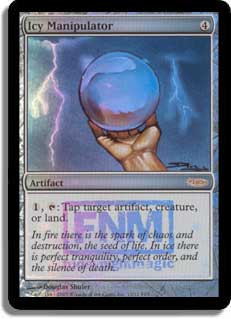
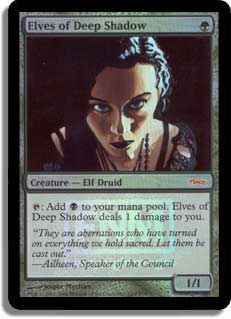
Starting in 2010, the DCI logo was replaced as the expansion symbol with the little shooting star that most promos have nowadays. Starting in April of 2011, the FNM watermark in use since Onslaught was replaced with a shooting star watermark as well. While both shooting stars have both survived to present day, that April of 2011 release also added the text ‘Friday Night Magic’ to the lower right hand corner of the card’s art. This change was apparently unpopular because it only lasted for three months.
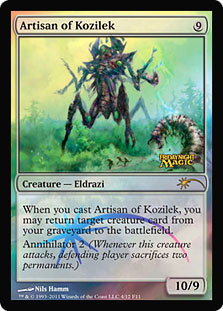
There have been many valuable FNM cards in the modern era, but none hold a candle to Brainstorm. FNM foil Brainstorm holds a $50 price tag, and even that is a little low considering the demand. Mother of Runes sells for $20. Eternal Witness sells for $15. Reanimate sells for $13. Rancor, Kitchen Finks, and Cabal Coffers sell for $12. Counterspell, Remand, Lightning Greaves, and Isochron Scepter sell for $10. Fact or Fiction and Oblivion Ring go for $8. Cabal Therapy goes for $7. Magma Jet goes for $6.
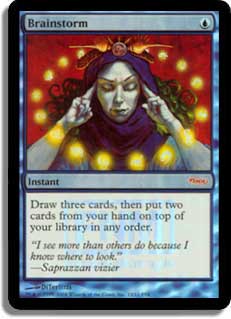
What do all of these cards have in common? They were all printed before 2010. Since Wizards began catering these promos more to Standard players, the prices have tanked. I do expect Lingering Souls and Ancient Grudge to eventually rise in value thanks to Eternal play, but the days of Brainstorm as an FNM card are long behind us. It’s a pity—ten years ago, rolling dice for random promos was a major part of FNM. Nowadays, it’s much more of an afterthought.
Summer of Magic
According to Wizards’ marketing team, 2007 was the ‘Summer of Magic.’ Since the predominant format of the day was Tenth Edition Limited, I’d argue that Magic had plenty of better summers, but that’s beside the point.
Regardless, in August and September of 2007, stores had the option of running sanctioned ‘Summer of Magic’ Limited formats. The prizes were foil promo copies of Treetop Village and Faerie Conclave, two popular lands that had just been reprinted in Tenth Edition. These promos don’t have alternate art but do have a ‘Magic: The Gathering’ watermark. The Conclave sells for $2.50 and the Village is worth $3.
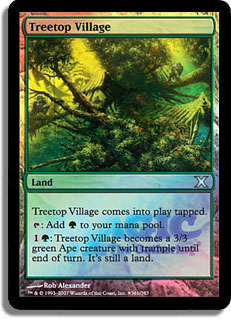
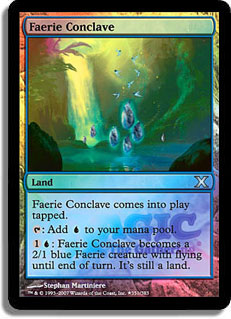
Target/Walmart Promos
Contrary to popular belief, most of those blister packs you see in the trading card section of your local Target and Walmart are actually official WotC products—not just sleazoid repacks. In order to reward people for buying these packs, many of which contained boosters from outdated sets, Wizards included an exclusive retail promo. There were four different ones initially made: Jaya Ballard, Task Mage, Brion Stoutarm, Broodmate Dragon, and Retaliator Griffin. All of them have the shooting star expansion symbol and a color pie watermark. The Jaya Ballard comes in the ‘starburst’ foiling style we discussed last week when we covered the JSS cards. The others are foiled normally.
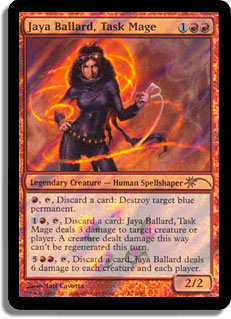
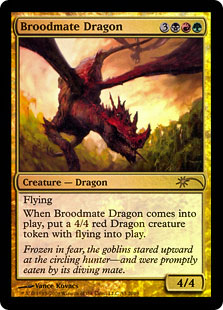
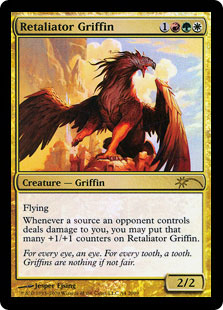
While the Broodmate Dragon was supposed to be released during Shards of Alara, very few actually were. For quite a while, these would pop up on eBay and sell for $80-$100 due to scarcity. About a year ago, a bunch of these started finally popping up and the price fell to $4. The Griffin is worth $3, and the other two are only worth $1 each.
Recently, three other retail promos have come out: Knight Exemplar, Terastodon, and Sunblast Angel. The Knight sells for $4, and the Sunblast Angel goes for $3. Terastodon is the most recent, and these have just started showing up in stores. They aren’t listed on SCG yet, but they’re only selling for $3-$5 on eBay.
Duels of the Planeswalker Promos
Since its release in 2010, Duels of the Planeswalkers has done an outstanding job of getting players to transition from the digital realm into the paper version of the game. One of the ways they do this is by offering everyone a free promotional card when they buy Duels. All you have to do is go down to your local store and pick it up.
A separate card was offered for each different platform that Duels is available on. Originally, XBOX users got Garruk Wildspeaker, Steam users got Nissa Revane, and PS3 players got Liliana Vess.
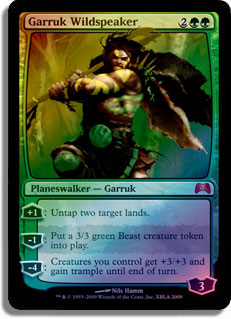
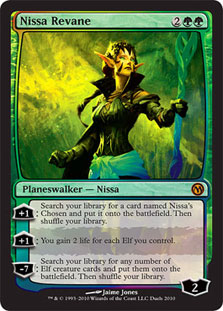
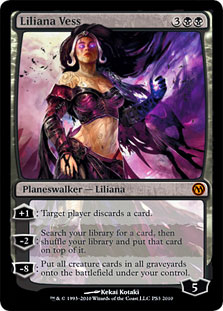
For Duels 2012, Steam users got Frost Titan, Playstation users got Inferno Titan, and XBOX users got Grave Titan.
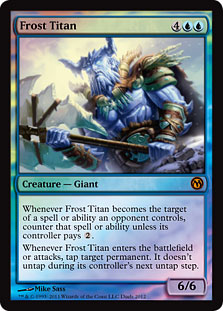
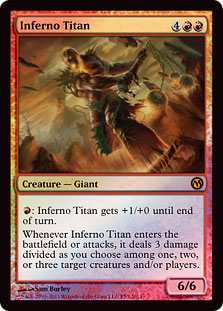
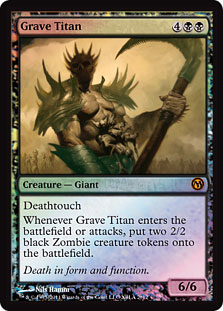
For Duels 2013, Playstation users get Vampire Nocturnus, XBOX players get Primordial Hydra, and iPad/Steam users get Serra Avatar. This promotion is still active, by the way—if you want one of these and you have a game system, go nuts.
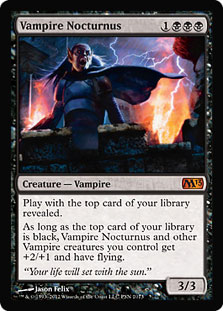
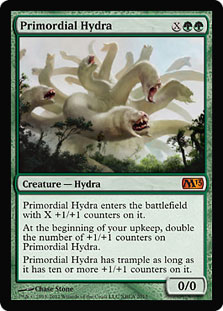
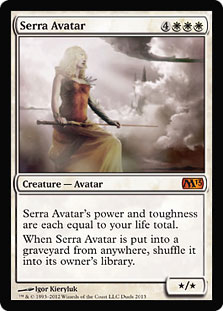
All of these cards have alternate art. Garruk has an XBOX controller for an expansion symbol, and the other 2011/2012 promos had the circular ‘M’ logo. The 2013 promos are different—not only do they have the regular M13 expansion symbol, but they aren’t foil.
All of these promos have value which has held or increased over time. Garruk and Liliana are the highest, coming in at $12 and $10 respectively. Nissa, Grave Titan, and Vampire Nocturnus sell for $8. Inferno Titan and Serra Avatar sell for $5.
…
The month after the fall set comes out is my favorite time of year to trade.
If you like swapping cards as much as I do, you should be doing as much of it as possible over the next few weeks. People are never more excited about Magic as they are right now, and demand for the new cards is through the roof. If you played in multiple Prerelease events, chances are you have a page or two of Return to Ravnica in your binder already. You’ll never have a better chance to move these cards for value, and going after older, more obscure cards is a favorite practice of mine. While many of the promos I mentioned are low value, they’re certainly worth grabbing as throw-ins when you can. When you do find a buyer, chances are he or she will be ecstatic—playable old promos are hard to find and can command a trade value above SCG retail.
Just make sure you focus on promos that are seeing play in one format or another, even if that format is casual. Only collectors are interested in unplayable promos, so if you ever find someone who is interested in yours, cut them a deal. It’s better to lose a little than to hold onto your unplayable promos for another few years.
Until next time—
—Chas Andres
